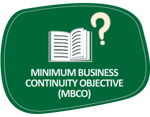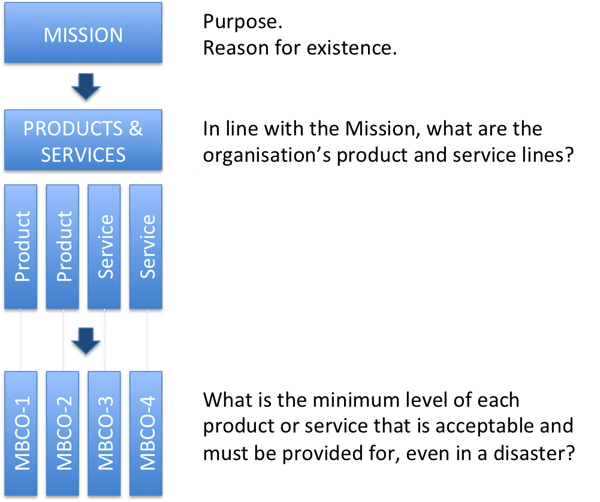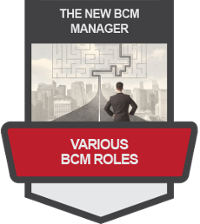In my previous post, we discussed the importance of getting the BCM manager and his team up to speed on all things BCM. That is a crucial step before we start the plan development process.
 Understanding Your Organisation
Understanding Your Organisation
Another step that would benefit the new BCM manager greatly as he goes about designing an organisation's Minimum Business Continuity Objectives, or MBCO, for the organisation, is to gather sufficient and relevant information about the organisation and the environment in which it operates.
- What is the business about?
- What is its mission and core purposes?
A clear understanding of the organisation's identity provides the underlying rationale for developing a business continuity plan and is a precursor for listing down the key products and services offered by the organisation.
The organisation's mission and its products and services are often publicly available on the company website, annual report, or in the training material provided at the New Employee Induction Programme.
Determining MBCO
 What is considerably more difficult to find, and in many cases, not available altogether, is the organisation's Minimum Business Continuity Objectives, or MBCO. These are the minimum committed levels for each of its key products and services, that must continue to be provided even in the face of disaster.
What is considerably more difficult to find, and in many cases, not available altogether, is the organisation's Minimum Business Continuity Objectives, or MBCO. These are the minimum committed levels for each of its key products and services, that must continue to be provided even in the face of disaster.
The MBCO is important because it informs the planning process by setting a minimum acceptable recovery target for the organisation. In arriving at the MBCO, consider the consequences of not being able to produce or provide each identified product and service, at a pre-determined quality, quantity or timeframe. What are the financial, operational, legal/regulatory, reputational, human and social impacts?
To produce a good MBCO, it is necessary first to understand the context within which the organisation is situated. The expectations of interested parties play a part in determining minimum service levels.
Interested Parties
Interested parties, in ISO parlance, is simply what used to be called stakeholders - basically, any group that might be interested in or affected by events occurring within the organisation, or decisions made by the organisation. These groups include customers, employees, suppliers and service providers, investors, regulators, and media channels.
Gather Expectations
Understandably, the BCM manager will need help gathering the expectations of so diverse a group and would need to approach others for help, e.g. Investor Relations department would probably be able to provide some idea of the expectations of investments where it pertains to business continuity.
Regulatory Environment
Understanding the regulatory environment also guides the BCM manager when determining the MBCO and business continuity strategies to use.

The mistake many BCM managers make concerning regulations is that they simply list down any government regulations they can think of, and consider the job done.
Understand Regulation Affecting BC Strategies
Far from it. BCM managers must make an effort to understand which aspects of the regulation affect recovery strategies and to what degree. It is one thing to say that the organisation must adhere to manpower regulations, and another to know that Part III of the Employment Act about that salaries needing to be paid within seven days after the end of the salary period, may have an impact on the RTO of the Payroll section of the HR department.
Risk Appetite
One other area the new BCM manager should also be interested in is the risk appetite of the organisation. The identification of management's risk appetite is important as it determines how much risk management is willing to tolerate, and hence their perception of what constitutes a high or low risk.
The MBCO and risk-related scales, such as impact scales and rating are influenced by the company's risk appetite, and hence the BCM manager should establish the risk appetite of the company as early as reasonably possible.
Next: Analysing the Gap of Your BCM System
My next post will focus on how a new BCM manager can conduct a gap analysis to identify potential areas for improvement within the organisation's BCMS.
Read "Perform a Gap Analysis on Your BCM Program."
The New Manager Series
 |
 |
 |
 |
 |
 |
 |
|
| Understand Your Organisation | Build Competency | Common Mistakes to Avoid | Various BCM Roles | Perform a Gap Analysis on Your BCM Program | Improve BCM Competency and Skill | BCM Job Description |
Need to Upgrade Your BCM Competency?
More Information About Blended Learning BCM-5000 [BL-B-5]
To know more about our blended learning program and when the next course is scheduled, feel free to contact our friendly course consultant colleagues via sales.ap@bcm-institute.org. They are the BL-B-3 Blended Learning BCM-300 ISO22301 BCMS Implementer and the BL-B-5 Blended Learning BCM-5000 ISO22301 BCMS Expert Implementer.
![FAQ [BL-B-3]](https://no-cache.hubspot.com/cta/default/3893111/b3824ba1-7aa1-4eb6-bef8-94f57121c5ae.png) |
Please feel free to send us a note if you have any of these questions to sales.ap@bcm-institute.org |
 |









